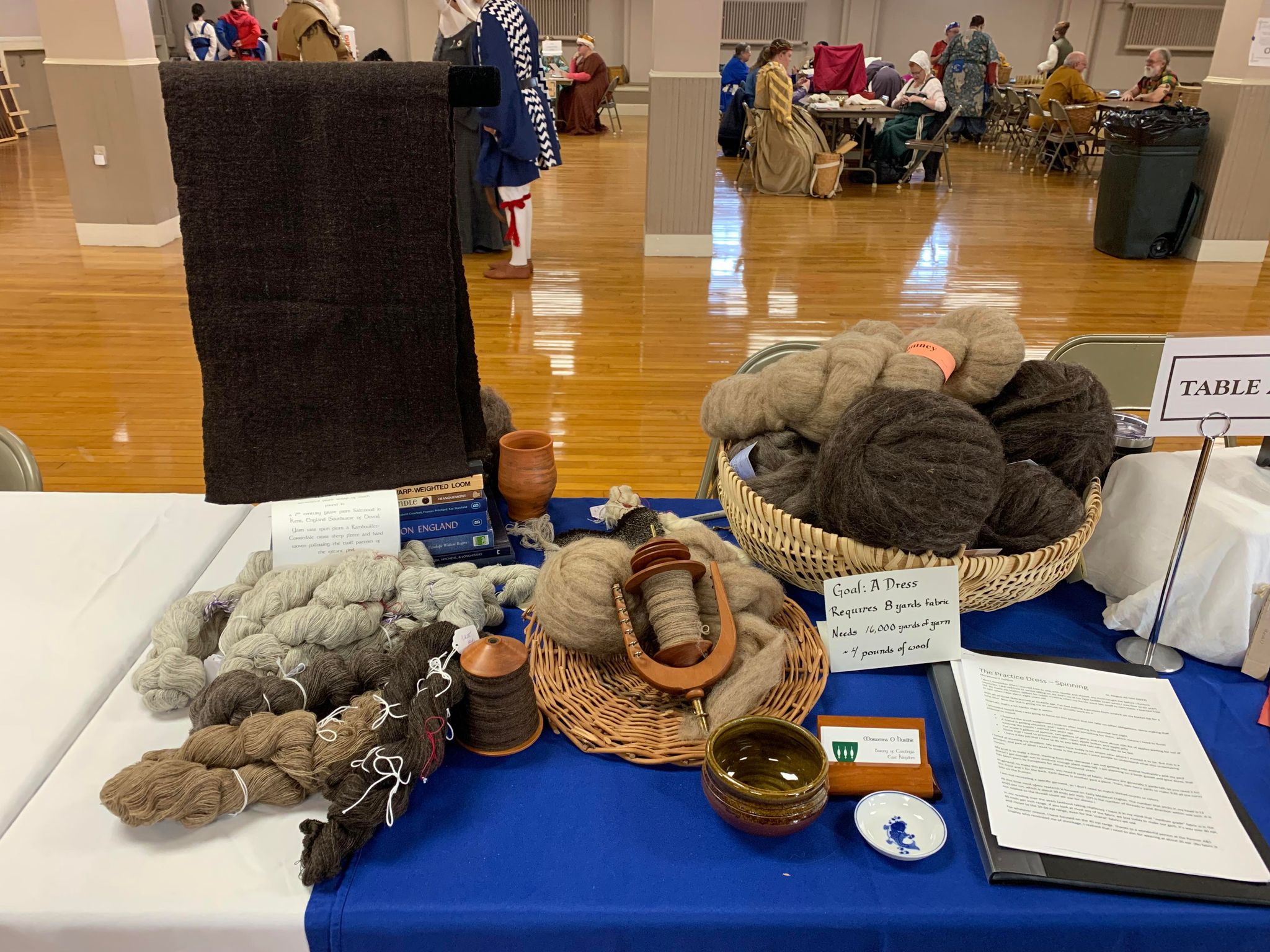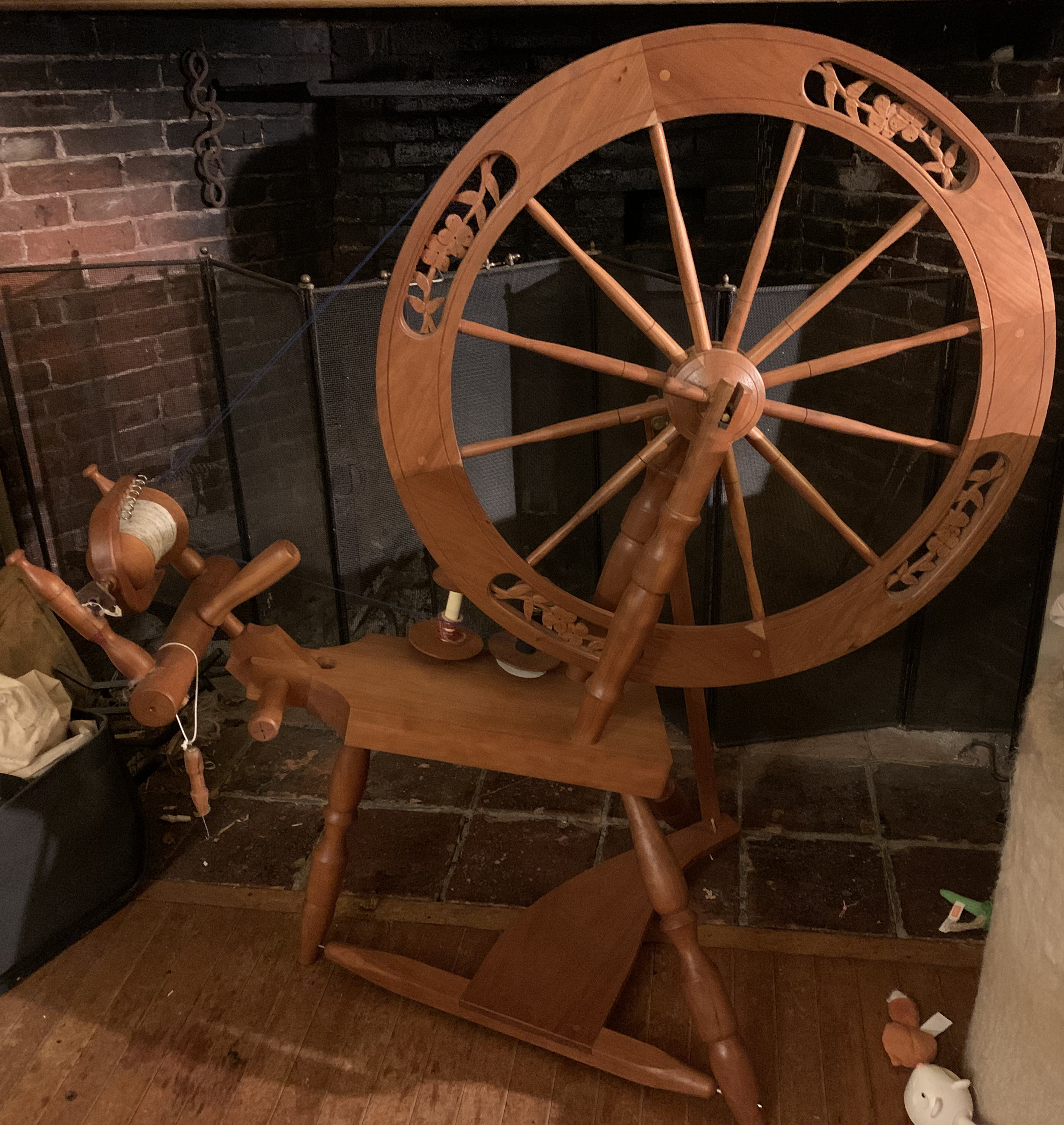Spinning

In an attempt to actually get going on this project again, I decided I would stop working on other projects and focus on my dress project. I would get all the spinning done for St. Elegius.
Back to Morwenna's main page.
- Back to Fiber to Frock
- Previous phase: Fabric


My display at St. Elegius, 2023
Spinning Yarn
As you can see, I didn't make the goal.
I don’t remember when I learned how to sew with needle and thread, my mom taught me before I formed memories. I learned how to weave sitting on my dad’s lap at his rigid heddle loom when I was four to six years old. He made me leather tablets for tablet weaving when my hands were too small to turn them. I learned how to spin when I was about eight years old.
With all of these skills learned at an early age, I’ve had making a garment from scratch on my bucket list for a long time. Now the SCA is giving me an excuse to actually work on it.
However, that’s a lot harder than it seems.
I promised myself that I was going to focus on this project and not take on other obligations. Since making that promise to myself:
- I finished the scroll assignment I took on after making this promise.
- A friend is getting elevated, and I want to make something for them, which means I need to finish weaving the towels I started two years ago.
- I’ve made 9 gallons of pyment, two gallons of perry, and I have about 200 lbs of apples waiting for me at home that I need to process into cider, cyser, apple butter, and apple jelly.
- I have a day job that I have to do to pay bills and two cats that like to be fed.
I failed at meeting my deadline. My project here today is no where near where I wanted it to be. But this is a process, and part of what I want to show is the process. I want people to understand what this undertaking means.
My goal is to make a dress, starting from fiber (because I am not getting into animal husbandry and my yard doesn’t get enough sun to produce enough plant material). I am planning on a basic gusset and gore dress, that has been worn by Europeans for about a thousand years.
In general, to make this garment, you need 8 yards of fabric. Humans are generally 2 yards tall, so you need 2 for the front and 2 for the back. Each sleeve is another yard a piece. Then, two more yards to make it fit all the curvy bits on the human.
I am not recreating a specific garment, so I don’t need to match thread counts or colors.
At this time most of my research is focused on Early Medieval English. The number that sticks in my head is 12 ends per cm, which is about 30 ends per inch. (EPI is the number of threads in one direction within one inch. It is not related to the thread count we use for sheets.)
In my reading over the years (without taking citations), I have it in my mind that “medium grade” fabric is in the 40 ends per inch range. If you look at most any of the fabric we buy today to make our garb, it’s way over 40 epi, and closer to the 50-60 epi range, even for the ‘coarse’ fabrics we use.
For whatever reason, I have focused on the 40 epi range. Thanks to a wonderful person at the Pennsic A&S Display who reminded me of shrinkage, I realized that I need to aim for weaving at about 36 epi. (No fabric is complete without finishing, which involves at least washing the fabric. That causes it to shrink a bit. How much it shrinks depends on the fiber and the weaving pattern, but 10% is a good guideline.)
To make a nice tabby (over one under one) weave, you generally need yarn that is double the number of wraps per inch vs the ends per inch. Wraps per inch is how many times you can wrap your yarn around a ruler and have it fit in one inch. You need more wraps per inch because to get the threads to lie flat in a weave, there needs to be space for them. So, for 36 epi weaving, my yarn needs to be around 72 wraps per inch. My brain can’t wrap around 1/72 of an inch (0.0138”), but it can wrap around 0.35mm. My current yarn is about 0.5mm, but since I don’t have a micrometer, I’m not exactly sure. I’m hoping it will work anyway.
I am going to weave this on my floor loom. Yes, someday I want to use a warp weighted loom, but I’m not quite there yet. I have a Schact Baby Wolf, which has a 24” weaving width.
I need 8 yards for the dress, but when you warp a loom, there is always loom waste because you have to tie the warp on, etc. In general, give yourself a yard of loom waste.
So, I’m going to need a 9 yard warp, 24” wide, 36 epi.
9 x 24 x 36 = 7,776 yards
That’s just the warp. I also need the weft, so double that.
7,776 x 2 = 15,552 yards
And that’s if everything works out perfectly. Say 16,000 because there will be breaks and problems. Plus I’ll need to use some of it as thread to stitch it together. I may also experiment with some of the interesting seam treatments where you tablet weave around the seams.
So, I need to spin 16,000 yards of yarn.
A year or two ago, I sat down and spun all day, just to see what I could do in a day. I didn’t push myself, and I am only a hobby spinner. After 8 to 10 hours of spinning, I had 880 yards.
At that rate, that’s 18 8 to 10 hour days to get the yarn I need. And that’s just the spinning. I’m cheating because I’m starting with mill prepared fiber. I’m also using a spinning wheel for this ‘practice dress’.
Also, at the diameter I am spinning, I am getting roughly 1,200 yards per 4 ounces of fiber. That’s 13.3 4 ounce bumps of fiber, or 3 1/3 lbs. I’m probably just going to go for 4 pounds.
I am spinning a combination of fibers. There’s some Romney, some Shetland, a cross that I liked, and mystery fiber that I forgot what it was. I believe all of them are ‘mid-grade’ wool, equivalent of what was available in the Early Medieval English time. (We’ve done a lot of breeding since then, and most breeders are going for the super soft and super fine wools that most modern hand spinners are looking for.) None of my fibers are dyed, and I’m working with different colors because I struggle with boredom. I would get tired trying to spin four pounds of the exact same fiber, so the different colors let me switch it up every 4 ounces.
They did have stripes and checks in period. For most of the early medieval English finds, multi-colored is rare, but it did exist. I will do some sort of stripe or check to help with my issue with crafting endurance. I don’t know exactly what I’m going to do. I’ll figure it out once all the yarn is done. With luck, that will be before the next St. Elegius.


The wheel I'm using to spin my yarn, inspired by a Canadian Production Wheel
Resources
- Østergård, Else. Woven into the Earth: Textiles from Norse Greenland. Aarhus: Aarhus UP, 2009. Print.
- Fransen, Lilli, Anna Nørgård, Else Østergård, and Shelly Nordtorp-Madson. Medieval Garments Reconstructed: Norse Clothing Patterns. Aarhus: Aarhus UP, 2011. Print
- Rogers, Penelope Walton. Costume in the Early Anglo-Saxon Cemetery at Saltwood, Kent Part 2 Textiles and costume. The Anglo-Saxon Laboratory, Pangur Press. 2014 <http://www.aslab.co.uk/pangur-press/>
- Uncounted books, conversations, videos, blogs, etc. on spinning and weaving that I have been reading for years and absorbing.
- Back to Fiber to Frock
- Previous phase: Fabric
Back to Morwenna's main page.